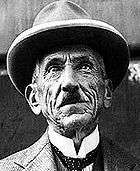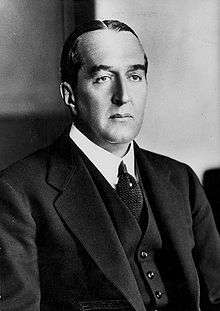1923 in Australia
The following lists events that happened during 1923 in Australia.
| 1923 in Australia | |
|---|---|
| Monarchy | George V |
| Governor-General | Henry Forster |
| Prime minister | Billy Hughes, then Stanley Bruce |
| Population | 5,693,369 |
| Elections | Queensland |
| |||||
| Decades: |
| ||||
|---|---|---|---|---|---|
| See also: | |||||
Incumbents
- Monarch – George V
- Governor General – Henry Forster
- Prime Minister – Billy Hughes (until 8 February), then Stanley Bruce
- Chief Justice – Adrian Knox
State premiers
- Premier of New South Wales – George Fuller
- Premier of Queensland – Ted Theodore
- Premier of South Australia – Henry Barwell
- Premier of Tasmania – John Hayes (until 13 August), then Sir Walter Lee (until 25 October), then Joseph Lyons
- Premier of Victoria – Harry Lawson
- Premier of Western Australia – James Mitchell
State governors
- Governor of New South Wales – Sir Walter Davidson (until 16 September)
- Governor of Queensland – Sir Matthew Nathan
- Governor of South Australia – Sir Tom Bridges
- Governor of Tasmania – none appointed
- Governor of Victoria – George Rous, 3rd Earl of Stradbroke
- Governor of Western Australia – Sir Francis Newdegate
Events
- 8 February – Billy Hughes resigns as Prime Minister, after the Country Party refuses to govern in coalition with him as the leader of the Nationalist Party. Hughes is succeeded by his Treasurer, Stanley Bruce.
- 25 April – The first Anzac Day dawn service is held in Albany, Western Australia.[1]
- 28 April – Construction commences on the Sydney Harbour Bridge.
- 1 to 30 April – A uniquely dry month over southeastern Australia due to a persistent block sees the driest month on record over Victoria with only 1.54 millimetres or 0.061 inches[2] and Tasmania with only 7.95 millimetres or 0.31 inches.[3] Melbourne has its only rainless month since at least 1855.
- 1 to 31 May – Following on the record dry April, Tasmania's weather reverses so abruptly that May remains the state's wettest month since at least 1900 with a statewide average of 370.92 millimetres or 14.60 inches.[3] The wet weather would continue for another eleven months so that May 1923 to April 1924 received a statewide average rainfall of 2,091.87 millimetres or 82.36 inches – the wettest twelve months on record over Tasmania.
- 14 August – John Hayes resigns as Premier of Tasmania after failing to resolve Tasmania's financial crisis. Sir Walter Lee becomes Premier for the second time.
- 28 August – Construction begins on the Provisional Parliament House in Canberra.
- 7 September – Harry Lawson assumes office for a second term as Premier of Victoria, forming a National-Country Party ministry.
- 10 October – Telephone link between Sydney and Brisbane officially opened.
- 12 October – Cairns, Queensland is proclaimed a city.
- 14 October – Severe floods in Melbourne, two people drown.
- 25 October – Sir Walter Lee is defeated in a no-confidence motion, and Joseph Lyons becomes Premier of Tasmania.
- 31 October – The Marble Bar heat wave begins, which by 7 April 1924 will hold the world record for the longest number of consecutive days (160) in which a temperature above 100 °F or 37.8 °C was recorded.[4]
- 1 November – The 1923 Victorian Police strike begins, with half of the Victoria Police force standing down over the use of labour spies. Rioting and looting takes place in the Melbourne city centre.[5]
Sport
- 20 October – Essendon wins the Premiership of the 1923 VFL season, defeating Fitzroy 8.15 (63) to 6.10 (46) at the MCG.
- Bitalli wins the Melbourne Cup
- Wynette wins the Caulfield Cup
- New South Wales wins the Sheffield Shield
- The 1923 NSWRFL Premiership culminates in Eastern Suburbs' victory over South Sydney in the final
Births
- 3 January – Bud Tingwell, actor (died 2009)
- 4 February – James Dibble, journalist (died 2010)
- 15 March – Lou Richards, Australian Rules footballer and media personality (died 2017)
- 5 May – Helen Cutler, charity worker and patron (died 1990)
- 21 May – Dorothy Hewett, poet and playwright (died 2002)
- 15 June – Ninian Stephen, Governor General of Australia (died 2017)
- 25 June – Harry Seidler, architect (died 2006)
- 28 July – Theo Bruce, long jumper (died 2002)
- 4 August – Reg Grundy, media owner (died 2016)
- 15 October – Lindsay Thompson, Premier of Victoria (died 2008)
Deaths
- 20 February – Abraham Tobias Boas (born 1844), Adelaide rabbi
- 22 February – John Jenkins (born 1851), Premier of South Australia (1901–1905)
- 18 March – Thomas Allwright Dibbs (born 1832), banker
- 2 June – Ted Banfield (born 1852), naturalist and author (Confessions of a Beachcomber)
- 4 June – Hume Nisbet (born 1849), artist
- 6 June – Sir Denison Miller (born 1860), first governor of the Commonwealth Bank
- 30 June – John Henry Nicholson (born 1838), teacher and writer
- 26 July – Bella Guerin (born 1858), feminist and suffragist
- 22 August – James Burns (born 1846), shipowner
- 30 August – Sir Pope Alexander Cooper (born 1848), chief justice of the Supreme Court of Queensland
- 14 September – Edward Millen (born 1860), journalist and politician
- 26 September – Charles Scrivener (born 1855), surveyor of Canberra
- 5 November – Dowell Philip O'Reilly (born 1865), poet, writer and politician
- 27 November – Penleigh Boyd (born 1890), artist
- 15 December – Frank Morton (born 1869), journalist and poet
- 19 December – Lawrence Hampton (born 1870)
- 23 December – Sir John Gordon (born 1850), judge and politician
References
- ANZAC Day Archived 21 July 2008 at the Wayback Machine, Department of Premier and Cabinet (Western Australia).
- Australian Bureau of Meteorology; All Months Rainfall Sorted — Victoria
- Australian Bureau of Meteorology; All Months Rainfall Sorted — Tasmania
- Marble Bar heatwave, 1923–24, Bureau of Meteorology.
- 1923 Police Strike, Museum Victoria.
This article is issued from Wikipedia. The text is licensed under Creative Commons - Attribution - Sharealike. Additional terms may apply for the media files.

